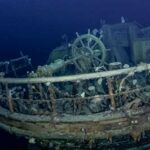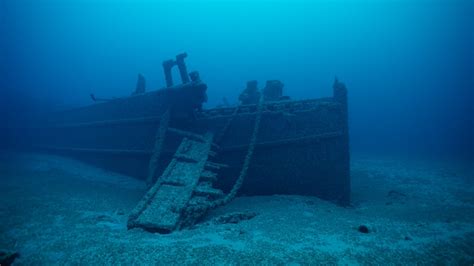
A remarkably well-preserved shipwreck, potentially the largest ever found, has been discovered off the coast of France, near Toulon, by a team conducting a seabed mapping mission for a gas pipeline project. The vessel, believed to be a massive cargo ship dating back to the late 6th or early 7th century AD, is estimated to be over 82 feet (25 meters) long, a size unprecedented for ships of that era.
The accidental discovery occurred during a routine survey by the company Deep Ocean Search (DOS), contracted by GRTgaz, France’s natural gas transport network operator. The team was using advanced sonar technology to map the seabed in preparation for laying a new gas pipeline when they stumbled upon the remarkably intact remains of the ancient vessel. According to a GRTgaz spokesperson, the discovery was “completely fortuitous” and took place at a depth of approximately 820 feet (250 meters).
The wreck’s excellent state of preservation is attributed to the depth at which it lies, where low oxygen levels and the absence of strong currents have minimized degradation. The ship’s wooden structure is largely intact, offering archaeologists a rare opportunity to study shipbuilding techniques and trade routes of the early medieval period. “Its size alone is exceptional,” stated a lead archaeologist involved in the preliminary examination. “Ships of this size were unheard of at that time.”
Initial investigations suggest the ship was likely involved in long-distance trade, possibly transporting goods between North Africa, Spain, Italy, and the regions now encompassing France. The ship’s size suggests a significant cargo capacity, indicating a sophisticated and well-organized maritime economy during the Merovingian dynasty.
Further investigation and excavation are planned to fully understand the ship’s construction, cargo, and eventual fate. The discovery promises to provide invaluable insights into maritime history, trade networks, and shipbuilding practices of the early medieval period in the Mediterranean.
The French Ministry of Culture has taken charge of the archaeological investigation, coordinating with marine archaeologists and other specialists to meticulously document and analyze the wreck. The site has been secured to prevent unauthorized access and ensure the preservation of the wreck. The detailed study of the shipwreck is expected to take several years and will involve cutting-edge technologies in underwater archaeology.
Details of the Discovery
Deep Ocean Search (DOS), a company specializing in deep-sea exploration and seabed mapping, was instrumental in the discovery. Employing state-of-the-art sonar equipment, the team was conducting a survey for GRTgaz to determine the safest route for a new natural gas pipeline. During this process, the sonar detected a large, unusual anomaly on the seabed. Closer inspection revealed the unmistakable outline of a ship, remarkably well-preserved despite centuries of submersion.
“The clarity of the sonar images was astonishing,” said a DOS technician involved in the survey. “We immediately recognized it as a shipwreck, and its size was immediately apparent. We knew we had found something significant.”
The depth of 820 feet (250 meters) presented challenges for initial investigation. Remotely Operated Vehicles (ROVs) equipped with high-definition cameras were deployed to capture detailed images and videos of the wreck. These images confirmed the ship’s impressive size and the exceptional condition of its wooden hull. The ROVs also collected preliminary data on the surrounding seabed, noting the presence of potential artifacts and other clues about the ship’s cargo and purpose.
The French Ministry of Culture was promptly notified of the discovery, and a team of marine archaeologists was dispatched to the site to conduct a preliminary assessment. The archaeologists confirmed the wreck’s age, size, and significance, emphasizing its potential to revolutionize our understanding of early medieval maritime history.
Historical Context
The shipwreck dates back to the late 6th or early 7th century AD, a period known as the Merovingian dynasty in France. This era followed the collapse of the Western Roman Empire and was characterized by political fragmentation, economic restructuring, and the rise of new kingdoms. Despite the challenges of this period, maritime trade remained a vital component of the Mediterranean economy.
The Merovingian kings controlled significant territories in what is now France, Germany, and parts of Italy. They fostered trade relationships with other regions, including North Africa, Spain, and the Eastern Mediterranean. Archaeological evidence suggests that goods such as wine, olive oil, textiles, pottery, and metalwork were commonly traded across these routes.
The discovery of such a large ship from this period challenges previous assumptions about the scale of maritime trade during the Merovingian dynasty. Historians and archaeologists have traditionally believed that ships of this era were relatively small, with limited cargo capacity. The newly discovered shipwreck suggests that larger vessels were indeed in use, capable of transporting significant quantities of goods over long distances.
“This discovery forces us to reconsider our understanding of maritime capabilities during the Merovingian period,” stated a historian specializing in early medieval trade. “It suggests a more sophisticated and robust maritime economy than we previously thought.”
Significance of the Ship’s Size
The size of the shipwreck, estimated to be over 82 feet (25 meters) long, is a key factor in its historical significance. Ships of this size were rare, if not unprecedented, in the late 6th and early 7th centuries AD. The average cargo ship of that era was typically much smaller, with a length of around 50 to 60 feet (15 to 18 meters).
The larger size of the discovered ship would have allowed it to carry significantly more cargo, making it more efficient for long-distance trade. This would have reduced the cost of transportation and increased the profitability of maritime ventures. The ship’s size also suggests a more complex and sophisticated level of shipbuilding technology than previously recognized.
The construction of such a large vessel would have required a skilled workforce, specialized tools, and a significant investment of resources. This implies a level of economic organization and technological expertise that is often underestimated in accounts of the Merovingian period.
“The sheer size of this ship is astonishing,” said a naval architect involved in the preliminary assessment. “It represents a significant advancement in shipbuilding technology for its time.”
Potential Cargo and Trade Routes
The exact nature of the ship’s cargo remains unknown, but archaeologists are hopeful that further investigation will reveal clues about its origin and destination. Based on historical evidence and the ship’s location, it is likely that it was involved in trade between North Africa, Spain, Italy, and the regions now encompassing France.
Potential cargo items include:
- Wine: Wine was a major trade commodity in the Mediterranean during the Merovingian period. Vineyards flourished in many regions, and wine was exported in large quantities to other parts of Europe and North Africa.
- Olive Oil: Olive oil was another essential commodity, used for cooking, lighting, and other purposes. Olive oil was produced in large quantities in Spain, Italy, and North Africa, and traded extensively throughout the Mediterranean.
- Textiles: Textiles, including wool, linen, and silk, were valuable trade goods. Textiles were produced in various regions and traded for other commodities.
- Pottery: Pottery was used for storing and transporting goods, as well as for everyday use. Different regions produced distinctive styles of pottery, which can help archaeologists trace trade routes.
- Metalwork: Metalwork, including tools, weapons, and decorative objects, was a valuable trade commodity. Different regions specialized in the production of certain types of metalwork, which were traded for other goods.
- Agricultural products: Grains, fruits, and vegetables were transported by sea, especially between regions with surpluses and those with shortages.
The ship’s size suggests that it was capable of carrying a diverse range of cargo items, making it a versatile vessel for long-distance trade. The discovery of cargo remains will provide valuable insights into the trade networks and economic relationships of the Merovingian period.
Preservation Challenges and Techniques
The preservation of the shipwreck presents significant challenges due to its location at a depth of 820 feet (250 meters). The deep-sea environment is characterized by low oxygen levels, high pressure, and cold temperatures, which can contribute to the degradation of wooden structures over time.
However, the low oxygen levels at this depth have also helped to slow down the decomposition process, allowing the ship to remain remarkably well-preserved for centuries. The absence of strong currents has also minimized physical damage to the wreck.
To ensure the long-term preservation of the shipwreck, archaeologists are employing a range of specialized techniques, including:
- 3D Scanning: High-resolution 3D scanning is used to create a detailed digital model of the wreck. This model can be used for research, documentation, and reconstruction purposes.
- Photogrammetry: Photogrammetry involves creating 3D models from overlapping photographs. This technique is used to document the wreck and its surrounding environment.
- Remote Operated Vehicles (ROVs): ROVs are used to conduct detailed inspections of the wreck, collect samples, and deploy preservation equipment.
- Specialized Lifting Techniques: If it is determined that the wreck or parts of it need to be raised, specialized lifting techniques will be employed to minimize damage.
- Conservation Treatment: Once artifacts are recovered from the wreck, they will undergo specialized conservation treatment to stabilize them and prevent further deterioration.
- In-situ Preservation: An in-situ preservation strategy will also be considered. This involves preserving the wreck in its current location by creating a protective barrier around it. This can involve covering the wreck with sediment or using chemical treatments to inhibit further decomposition.
The preservation efforts are being coordinated by the French Ministry of Culture, in collaboration with leading marine archaeologists and conservation specialists. The goal is to ensure that this invaluable piece of maritime history is preserved for future generations.
Implications for Maritime History
The discovery of the Merovingian shipwreck has profound implications for our understanding of maritime history. It challenges existing assumptions about the size and capabilities of ships during the early medieval period. It provides new insights into the trade networks, economic relationships, and shipbuilding practices of the Merovingian dynasty.
The discovery is also significant because it highlights the importance of deep-sea exploration and archaeological research. Many shipwrecks and other archaeological sites remain undiscovered on the seabed, representing a vast reservoir of historical information. As technology advances, it becomes increasingly possible to explore these sites and unlock their secrets.
“This discovery is a game-changer for maritime history,” said a leading marine archaeologist. “It will rewrite our textbooks and force us to reconsider our understanding of the early medieval period.”
The detailed study of the shipwreck is expected to take several years and will involve a multidisciplinary team of experts. The results of this research will be published in scientific journals and shared with the public through museum exhibitions and educational programs.
Future Research and Excavation
The initial investigation of the shipwreck is just the beginning. Extensive research and excavation are planned to fully understand the ship’s construction, cargo, and eventual fate. The research will involve a combination of underwater archaeology, historical analysis, and scientific techniques.
Future research plans include:
- Detailed Mapping of the Wreck: A comprehensive map of the wreck will be created using 3D scanning and photogrammetry. This map will serve as a baseline for future research and conservation efforts.
- Excavation of the Ship’s Interior: The interior of the ship will be carefully excavated to recover any remaining cargo or artifacts.
- Analysis of the Ship’s Wood: Samples of the ship’s wood will be analyzed to determine its species, age, and origin. This will provide valuable information about the ship’s construction and trade routes.
- Study of the Ship’s Design: The ship’s design will be studied to understand its performance characteristics and shipbuilding techniques.
- Comparison with Other Shipwrecks: The shipwreck will be compared with other shipwrecks from the same period to identify similarities and differences.
- Historical Research: Historical documents and other sources will be examined to learn more about the trade networks and economic relationships of the Merovingian period.
The excavation and research efforts will be conducted in a careful and methodical manner to ensure the preservation of the shipwreck and its artifacts. The results of this research will be shared with the public through publications, exhibitions, and educational programs.
The discovery of this record-setting shipwreck represents a significant milestone in maritime archaeology. It provides a unique opportunity to learn about the past and to preserve our cultural heritage for future generations. The ongoing research and preservation efforts will ensure that the legacy of this remarkable vessel endures for centuries to come. The French Ministry of Culture is committed to supporting this important work and to sharing the findings with the world. The site is currently under strict protection to ensure no damage occurs.
Frequently Asked Questions (FAQ)
1. Where was the shipwreck discovered, and who discovered it?
The shipwreck was discovered off the coast of France, near Toulon, at a depth of approximately 820 feet (250 meters). It was discovered by Deep Ocean Search (DOS), a company contracted by GRTgaz, while conducting a seabed mapping mission for a gas pipeline project.
2. How old is the shipwreck, and what historical period does it belong to?
The shipwreck dates back to the late 6th or early 7th century AD, during the Merovingian dynasty in France. This period followed the collapse of the Western Roman Empire and was characterized by political fragmentation and economic restructuring.
3. What makes this shipwreck so significant?
The shipwreck is significant due to its remarkably well-preserved state and its unprecedented size for a ship of that era. At an estimated length of over 82 feet (25 meters), it suggests a more sophisticated maritime economy and shipbuilding technology than previously understood for the Merovingian period. It challenges existing assumptions about the size and capabilities of ships during the early medieval period.
4. What types of cargo might the ship have been carrying, and what trade routes was it likely involved in?
The exact cargo is currently unknown, but possibilities include wine, olive oil, textiles, pottery, and metalwork. Based on its location and historical context, the ship was likely involved in trade between North Africa, Spain, Italy, and the regions now encompassing France.
5. What are the plans for the shipwreck’s preservation and further study?
The French Ministry of Culture has taken charge of the archaeological investigation and preservation efforts. Plans include detailed mapping of the wreck, excavation of the ship’s interior, analysis of the ship’s wood, and study of its design. Specialized techniques such as 3D scanning, photogrammetry, and the use of remotely operated vehicles (ROVs) will be employed. Options for in-situ preservation are also being considered. The wreck site is under strict protection to prevent any damage or unauthorized access.









